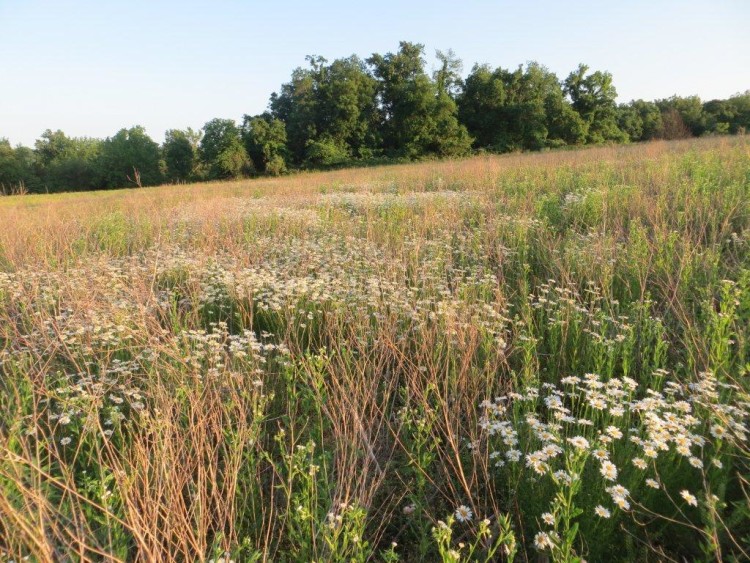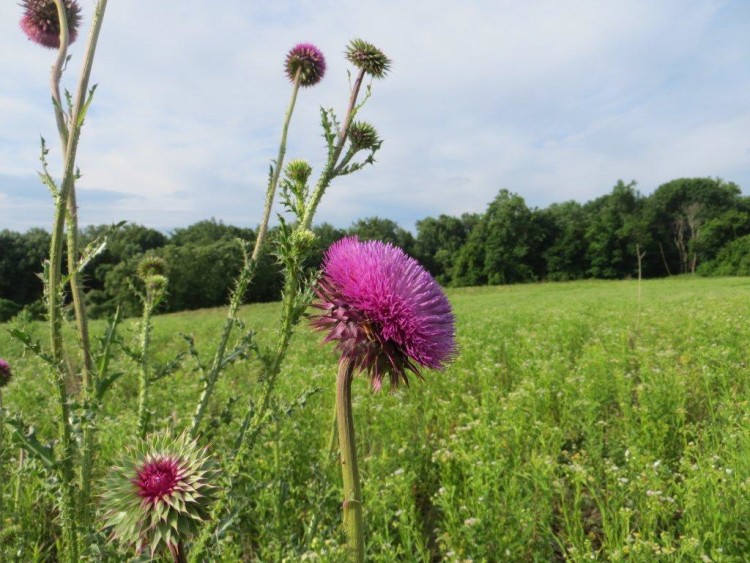Next door, twenty four and one-half acres went up for sale over a year ago; the fields have not been sprayed with herbicides or insecticides for 25 months. After being planted in corn five years in a row, they have lain fallow, and now are coming back, the monoculture defunct and life by the battalion gone rampant.
Two springs have brought forth these plants: Wild Heath Aster — our great grandmothers and aunts when young would wrap the blossoms in a sachet and wear it around their throats so that they might win another’s love; in the tens-of-thousands it crowds the eye from tree line to tree line. Oxeye Daisy; ankle high Cherry Tree saplings; tulip poplar seedlings one hundred yards from the forest; Broadleaf Dock, called Indian Tobacco for the brown grains of its seed pods; Yellow Sweet Clover and White Clover, the bees already at work in the blooms; Mustard; the early shoots of Pokeberry, whose berries will poison us but whose flower attracts hummingbirds; Blackberry; Sassafras saplings creeping in from the edges of the tree lines; Wild Strawberry, Marestail, a few Multi-Flora Rose — to rid a pasture of these, they must be burned out; Canadian Thistle, whose seeds were mixed with the farm seeds of French settlers in the 1600’s or tangled in their woolen trousers and shawls; Bull Thistle, chest high in early June, bladed, topped by a rose-purple flower like a beacon — one can eat its young stems and roots; Goldenrod — crush it and spread it on a wound if you want it to close and heal; in one spot only, Yellow Goatsbeard; And soft, so soft light gray-blue Lamb’s Tongue.
I have seen the same button buck raise his head at our approach and then breaking the wave of asters go gazelling towards the woods. Mourning doves have begun to take cover among the expanding shadows of stems. Catbirds and Towhees sing from the deep brambles and vines on the verges and an Indigo Bunting family has been nesting in the center wood line since we first began walking here 17 years ago. The razor sharp morning light reveals spider webs. Jumping spiders were the first insects I saw here in any numbers, but now — every buzzing, whirring creature in the menagerie. Cabbage whites have been the first butterflies to appear. Oh to be an entomologist, botanist, ornithologist — or just a minor god with the faculty to restore that which has been ravaged — a save-ologist. Patti and I have talked about a space like this brought back to the old life, rich with native grasses and birds — a Meadowlark Project, a patch saved for the things that should go on apart from the mercenary desires of the marketplace. However, those contradictions never go away — 600K for these acres which have been farmed for over 200 years.
The field is stepping into the process of Succession, the eco-technical term, but standing in the middle of it today after heavy rains, I can only think about the powers of resilience and recovery intrinsic to nature, and I find hope in the mechanisms of its breathing and movement and surprises and steady push forward.



